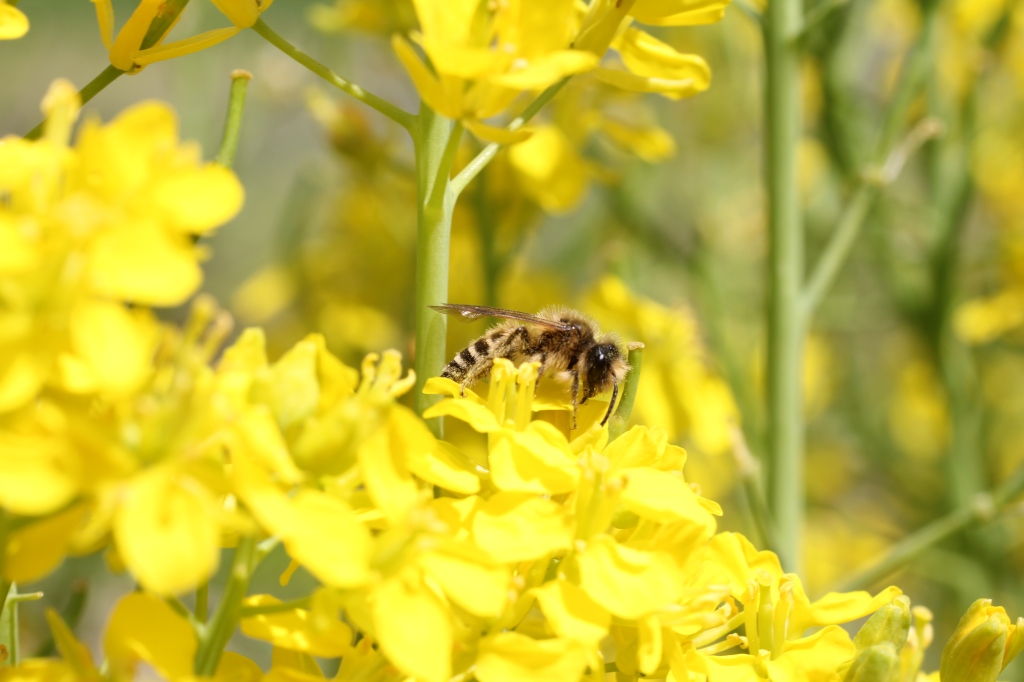Laura Riggi talks us through the latest research, conducted with colleagues, which confirms that mass-flowering crop cultivation alone is unlikely to be sufficient for maintaining pollinators. However, as part of carefully designed diverse crop rotations or mixtures combined with the preservation of permanent non-crop habitats, it might provide valuable supplementary food resources for pollinators in temperate agroecosystems, particularly later in the season when alternative flower resources are scarce.
Pollinators and intensified agriculture
The intensification of farming practices has led to the transformation of agricultural landscapes. Previously, these landscapes consisted of small mosaics of fields connected to flower-rich meadows by many undisturbed field borders. However, they have now transformed into vast, monotonous fields cultivating only a few crop types. Such simplified landscapes have left bees and other wild insect pollinators hanging in the air, because undisturbed nesting sites and nearby diverse flowering resources needed to survive and reproduce are hard to find.
As a result, intensified agriculture has driven a drastic decline in numbers and diversity of wild pollinators. In an effort to make agricultural landscapes more pollinator-friendly, there have been suggestions to promote flowering crops. These crops, by providing more pollen and nectar might help pollinator communities in temperate agricultural landscapes.
As a result, in early spring, expansive fields of oilseed rape paint the landscapes in vibrant yellow, while later in the season, patches of red clover and white faba bean carpets emerge. The intensity of the boom and bust cycles of resource provision from these flowering crops are however far away from natural resource provisions as they are found in plant rich meadows, and their effects on pollinator communities are context-dependent and difficult to summarize for management recommendations.
The impact of flowering crops on wild pollinators
The manuscript titled “Early season mass-flowering crop cover dilutes wild bee abundance and species richness in temperate regions: a quantitative synthesis” presents a comprehensive exploration of the impact of flowering crops on wild pollinators, addressing three key questions:
- Does it matter if the crops flower early or late in the season?
- Are all pollinator groups affected in similar ways?
- What are the consequences for pollinator communities after the crops stop blooming?
While this study confirms previous findings that suggests that increasing early-season flowering crop cultivation leads to dilution of wild bees in crop habitats during bloom, we add an interesting finding: when looking at late flowering crops the dilution effect may even disappear for some pollinator groups. This suggests that flowering crops may provide crucial flower resources during periods of nectar and pollen scarcity, known as the pollinator hunger gap, characteristic of temperate agricultural landscapes.
Therefore, while increasing cultivation of early-season flowering crops may pose challenges through: dilution effects, cultivation of late-season flowering crops could offer crucial resources, especially when alternative floral resources in non-crop habitats are limited.
Inclusion of late-season flowering crops in crop rotations, such as legumes (clover and faba bean), might provide attractive resources for crop adapted species, such as honeybees and some bumblebees and alleviate competition for flower resources in non-crop habitats.
However, we should not forget about the importance of pastures and other non-crop habitats for pollinators. In this study we show that these types of habitats have positive effects in abundances of wild pollinators like bumblebees.
Suggestions
The findings emphasize the need for carefully designed diverse crop rotations or crop mixtures, such as intercropping or under-sowing, to provide resources at different times of the season. The study encourages a more holistic approach to pollinator conservation, suggesting that while flowering crops alone may not be sufficient, when combined with the preservation of permanent non-crop habitats, they can offer supplementary food resources for crop-adapted pollinators.
This research sets the stage for further investigations into the specific traits of pollinator species that benefit from flowering crops, ultimately guiding effective strategies for pollinator conservation in agricultural landscapes.
Read the full article “Early season mass-flowering crop cover dilutes wild bee abundance and species richness in temperate regions: a quantitative synthesis” in Journal of Applied Ecology





Your blog is a great way for kids to get interested and involved in ecology. As an IB ESS tutor, it gives me great pleasure to know kids as young as 10 are active in their communities and exchanging info they read.
LikeLike